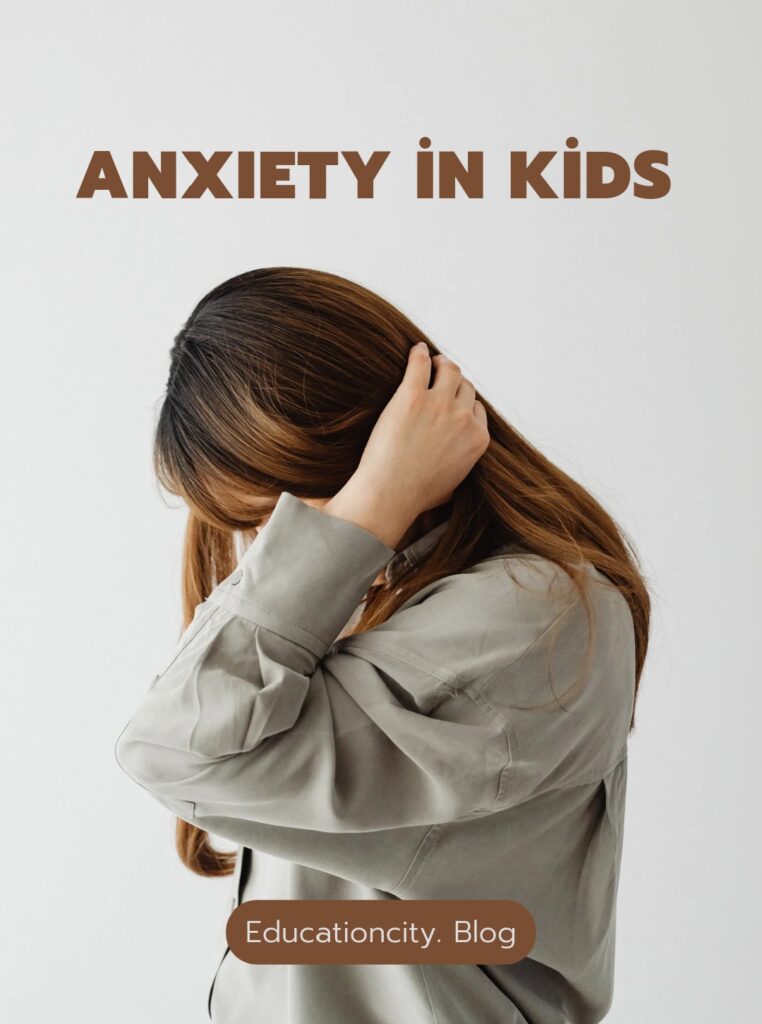Anxiety in kids
Anxiety in kids is a natural emotion that everyone experiences at some point. It’s part of the human condition to feel worried or nervous when faced with new or challenging situations. However, when anxiety becomes excessive, persistent, and begins to interfere with daily life, it may signal an anxiety disorder. This can happen not only to adults but also to children, who may be less equipped to recognize and manage these overwhelming feelings. Anxiety in kids is often overlooked or misunderstood, yet it’s an important issue to address.
In this blog, we’ll explore the causes of anxiety in children, common symptoms, and practical ways parents, caregivers, and educators can help kids manage their anxiety. By understanding the signs and knowing how to provide support, we can create an environment where children feel safe to express their emotions and learn coping mechanisms.
What Is Anxiety in Kids?
Anxiety in children is characterized by excessive worry, fear, or nervousness about everyday situations. While it is normal for kids to feel anxious from time to time—such as before a test, performance, or when starting a new school—persistent anxiety can affect their ability to enjoy life and succeed in academic or social settings. Anxiety disorders are one of the most common mental health problems affecting children.
There are several types of anxiety disorders that can affect anxiety in kidkids:
Generalized Anxiety Disorder (GAD): Children with GAD may worry about a wide range of everyday things, such as school, health, family, and friendships, often to a degree that’s disproportionate to the actual situation.
Separation Anxiety Disorder: This involves an intense fear of being away from a parent or caregiver. Children may worry that something bad will happen to them or their parents during the separation.
Social Anxiety Disorder: Kids with social anxiety disorder have an overwhelming fear of social situations, especially where they feel they might be judged or embarrassed. This can include public speaking, participating in group activities, or even simple interactions with peers.
Specific Phobias: A specific phobia is an intense fear of a particular object or situation, such as heights, dogs, or the dark. While many kids have fears, these phobias can lead to avoidance behaviors and cause significant distress.
Common Causes of Anxiety in Kids
Understanding the root causes of anxiety in children is essential for providing appropriate support. While the specific reasons vary from child to child, several common factors contribute to the development of anxiety disorders in kids:
- Genetics: Anxiety in kidsoften runs in families. If a child has a parent with anxiety or another mental health disorder, they may be more likely to develop anxiety themselves. This genetic predisposition can make a child more susceptible to stress.
- Brain Chemistry: Imbalances in brain chemicals, such as serotonin and dopamine, can contribute to anxiety anxiety in kids. These neurotransmitters play a role in regulating mood and stress, and disruptions in their balance may increase the risk of anxiety disorders.
- Environmental Factors: Traumatic or stressful experiences can trigger anxiety in children. Moving to a new home, losing a loved one, parental divorce, or witnessing violence can create lasting emotional scars. Additionally, high expectations at school or at home can add to a child’s stress.
- Parenting Styles: Overprotective or overly critical parenting can contribute to anxiety. Children may feel incapable of handling situations on their own or fear making mistakes if they sense constant monitoring or criticism.
- Social Pressures: Peer pressure, bullying, or feeling different from others can lead to social anxiety. The desire to fit in and the fear of rejection or embarrassment can create a lot of stress for children, particularly in the pre-teen and teenage years.
- Learning Challenges or Disabilities: Children with learning disabilities, ADHD, or other developmental disorders may experience anxiety related to academic performance, fitting in with their peers, or managing day-to-day tasks that feel more difficult for them than others.Anxiety in kids

Signs and Symptoms of Anxiety in Kids
Recognizing anxiety in children can be challenging because they often lack the vocabulary or understanding to explain what they’re feeling. Additionally, anxiety in kids may not always look like worry or fear. Some common symptoms include:
- Physical Symptoms:
Frequent stomachaches or headaches with no medical explanation
Difficulty sleeping or frequent nightmares
Restlessness, fidgeting, or inability to relaxAnxiety in kids
Sweating, trembling, or feeling dizzy
Rapid heartbeat or shortness of breath
- Emotional Symptoms:
Excessive worry about everyday activities
Fear of being separated from parents or caregivers
Intense fear of specific situations or objects (phobias)
Avoidance of social interactions or situations that cause anxiety
Sudden outbursts of anger or irritability
Difficulty concentrating or staying focused
- Behavioral Symptoms:
Clinginess or refusal to leave parents’ side
Avoiding activities they used to enjoy, such as playdates, sports, or school
Frequent reassurance-seeking (e.g., asking if they are safe, if something bad will happen)
Crying or tantrums when faced with stressful situations
How Anxiety in kids Affects Children’s Lives
Unchecked anxiety can impact nearly every aspect of a child’s life. In school, children with anxiety may have trouble concentrating, completing assignments, or participating in class discussions. Their academic performance may suffer as a result, not because of a lack of intelligence but because their anxious thoughts prevent them from focusing or enjoying learning.
Socially, anxiety can limit a child’s ability to make friends or engage in group activities. They may avoid social interactions out of fear of embarrassment or rejection, which can lead to loneliness and isolation. Children with social anxiety, in particular, may shy away from extracurricular activities like sports, theater, or clubs, missing out on important developmental experiences.
Emotionally, children with anxiety may experience low self-esteem and a sense of inadequacy. They may constantly question their abilities or worry about making mistakes, leading to feelings of frustration or sadness. Over time, chronic anxiety can increase the risk of developing depression or other mental health disorders.
How to Help Children with Anxiety
Supporting a child with anxiety involves a combination of empathy, understanding, and practical strategies. Here are some ways parents, caregivers, and educators can help:
- Encourage Open Communication
One of the most important steps in helping a child with anxiety in kids is creating an open line of communication. Encourage your child to talk about their feelings and fears without judgment. It’s crucial to listen to them without immediately trying to fix the problem or dismiss their concerns. Acknowledging their feelings helps them feel understood and validated.
- Teach Coping Mechanisms
Teaching children healthy coping mechanisms can empower them to manage their anxiety. Some strategies include:
Deep Breathing: Practicing slow, deep breaths can help reduce physical symptoms of anxiety like rapid heartbeat and shallow breathing.Anxiety in kids
Mindfulness and Meditation: Encouraging children to stay present and practice mindfulness can help them avoid getting stuck in anxious thoughts about the future or past.
Visualization: Guiding children through visualization exercises, where they imagine a calm, safe place, can help reduce feelings of stress.
Positive Self-Talk: Teaching children to replace negative thoughts with positive affirmations can improve their ability to cope with anxiety.Anxiety in kids
- Create a Structured Routine
Children often feel more secure when they know what to expect. Establishing a predictable daily routine can help reduce anxiety by providing a sense of control and stability. Ensure that the routine includes time for relaxation and unstructured play, which allows children to unwind and decompress.
- Gradual Exposure to Fears
For children with specific phobias or social anxiety, gradual exposure to the situations that cause fear can be helpful. Start by introducing small, manageable exposures and gradually work up to more challenging situations. For example, if a child is afraid of public speaking, start by having them speak in front of a small, supportive group before building up to a larger audience.
- Limit Avoidance Behaviors
While it may be tempting to shield a child from situations that trigger anxiety, avoidance can actually reinforce the fear over time. Instead, encourage your child to face their fears with the right support. This helps them build resilience and confidence.
- Set Realistic Expectations
Children with anxiety kids >8often feel overwhelmed by high expectations, whether they come from school, family, or their own internal pressures. Help your child set realistic goals and celebrate small achievements along the way. Let them know that it’s okay to make mistakes and that learning from them is part of growth.
- Seek Professional Support
If your child’s anxiety in kids dpersists or interferes significantly with their daily life, it may be time to seek professional help. Therapists specializing in cognitive-behavioral therapy (CBT) can work with children to identify negative thought patterns and develop coping strategies. In some cases, medication may be prescribed to help manage severe anxiety symptoms.
Conclusion
Anxiety in children is a common but often misunderstood condition. By understanding the causes, recognizing the symptoms, and providing compassionate support, parents and caregivers can help children navigate their anxiety in a healthy way. It’s important to create an environment where kids feel safe to express their fears and learn coping mechanisms that will serve them throughout their lives.
Children need to know that anxiety is not something they have to face alone. With the right tools and support, they can develop resilience, confidence, and the ability to manage their anxiety effectively, leading to a happier and more fulfilling childhood
read mmore Addressing Anxiety in Children: Signs and Coping Strategies
view more https://youtu.be/8rddM0ggYKo?si=aXU-UkGlYSHASIst
.
